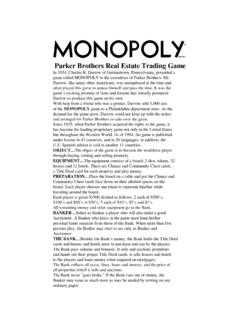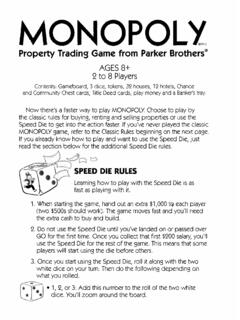Transcription of For 2 to 6 players / Ages 10 to adult - Hasbro
1 For 2 to 6 players / Ages 10 to adult Rules 1959,1963,1975,1980,1990,1993 Parker Brothers, Division of Tonka Corporation, Beverly, MA 01915. Printed in TABLE OF CONTENTS. Introduction & Strategy Hints .. 3. Equipment .. 3. RISK , the classic WORLD DOMINATION game .. 5. Setup, including initial placement of armies .. 5. Playing .. 6. Getting and placing new armies ..6. RISK cards .. 7. Attacking .. 8. Determining the winner of the dice roll .. 9. Fortifying your position .. 10. Winning ..10. Variation: RISK for 2 players ..ll Variation: CAPITAL RISK for a Shorter Game .. 12. SECRET MISSION RISK .. 13. Rules Variations for RISK Experts .. 15. RISK Tournaments .. 16. INTRODUCTION & STRATEGY HINTS. In the classic World Domination RISK game of military strategy, you are battling to conquer the world.
2 To win, you must launch daring attacks, defend yourself on all fronts, and sweep across vast continents with boldness and cunning. But remember, the dangers, as well as the rewards, are high. Just when the world is within your grasp, your opponent might strike and take it all away! See pages 1l- 16 for gameplay variations and variations for RISK experts. Strategy. In all the RISK games, keep these 3 strategy hints in mind as you play, add armies, and fortify: 1. Conquer whole continents: You will earn more armies that way. (This doesn't apply in Secret Mission Risk.). 2. Watch your enemies: If they are building up forces on adjacent territories or continents, they may be planning an attack. Beware!
3 3. Fortify borders adjacent to enemy territories for better defense if a neighbor decides to attack you. EQUIPMENT. 1 Tri-fold Game Board l 5 Dice: 2 white and 3 red l Deck of 56 RISK cards l 6 Sets of armies, each a different color The Game Board. The game board is a map of 6 continents divided into 42 territories. Each continent is a different color and contains from 4 to 12. territories. The numbers along the bottom (southern) edge of the board indicate the number of armies you will receive for a set of cards you trade in, as explained on page 7. The Armies. There are 6 complete sets of armies, each containing 3. denominations of army pieces: Infantry (worth l), Cavalry (worth 5. Infantry), and Artillery (worth 10 Infantry, or 2 Cavalry).
4 Start the game by placing Infantry pieces; later in the game, you may trade in 5 Infantry for 1 Cavalry, or 2 Cavalry (or 1 Cavalry and 5 Infantry) for 1 Artillery. Infantry Cavalry Artillery 1 army 5 armies 10 armies . The 56 RISK@ Cards: 42 marked with a territory and a picture of Infantry, Cavalry, or Artillery 2 wild cards marked with all three pictures, l but no territory 12 Secret Mission cards used only in Secret Mission Risk, l page 13. Sample RISK Cards: I Argentina India Western Infantry Cavalry Sample Secret Mission Card: Note: The 12 Secret Mission cards are used only in the Secret Mission RISK variation. Remove them for all other games. WORLD DOMINATION RISK . OBJECT OF THE GAME. To conquer the world by occupying every territory on the board, thus eliminating all your opponents.
5 SETUP. Unlike most games, RISK demands careful planning before you actually start to play. This Initial Army Placement sets the stage for the battles you'll fight later on. INITIAL ARMY PLACEMENT consists of these steps: 1. Select a color and, depending on the number of players , count out the armies you'll need to start the game. If 2 are playing, see instructions on page 11. If 3 are playing, each player counts out 35 Infantry. If 4 are playing, each player counts out 30 Infantry. If 5 are playing, each player counts out 25 Infantry. If 6 are playing, each player counts out 20 Infantry. 2. Roll one die. Whoever rolls the highest number takes one Infantry piece from his or her pile and places it onto any territory on the board, thus claiming that territory.
6 3. Starting to the left of the first player, everyone in turn places one army onto any unoccupied territory. Continue until all 42 territories have been claimed. 4. After all 42 territories are claimed, each player in turn places one additional army onto any territory he or she already occupies. Continue in this way until everyone has run out of armies. There is no limit to the number of armies you may place onto a single territory. To complete game SETUP: 5. Shuffle the pack of RISK cards (remove the Mission cards) and place it, face down, by the side of the board. This pack forms the draw pile. 6. Whoever placed the first army takes the first turn. PLAYING. On your turn, try to capture territories by defeating your opponents'.
7 Armies. But be careful: Winning battles will depend on careful planning, quick decisions and bold moves. You'll have to place your forces wisely, attack at just the right time and fortify your defenses against all enemies. Note: At any time during the game, you may trade in Infantry pieces for the equivalent (see page 4) in Cavalry or Artillery if you need to, or wish to. Each of your turns consists of three steps, in this order: 1. Getting and placing new armies;. 2. Attacking, if you choose to, by rolling the dice;. 3. Fortifying your position. GETTING AND PLACING NEW ARMIES. At the beginning of each turn, calculate how many new armies you'll add to your territories based on .. 1. The number of territories you occupy.
8 2. The value of the continents you control;. 3. The value of the matched sets of RISK cards you trade in;. 4. The specific territory pictured on a traded-in card. Territories. At the beginning of every turn (including your first), count the number of territories you currently occupy, then divide the total by three (ignore any fraction). The answer is the number of armies you receive. Place the new armies on any territory you already occupy. Example: 11 territories = 3 armies 14 territories = 4 armies 17 territories = 5 armies You will always receive at least 3 armies on a turn, even if you occupy fewer than 9 territories. Continents. In addition, at the beginning of your turn you will receive armies for each continent you control.
9 (To control a continent, you must occupy all its territories at the start of your turn.) To find the exact number of armies you'll receive for each continent, look at the chart in the lower left-hand corner of the game board. RISK CARDS. Earning Cards. At the end of any turn in which you have captured at least one territory, you will earn one (and only one) RISK card. You are trying to collect sets of 3 cards in any of the following combinations: 3 cards of same design 1 each of 3 designs any 2 plus a wild card (Infantry, Cavalry, or Artillery). If you have collected a set of 3 RISK cards, you may turn them in at the beginning of your next turn, or you may wait. But if you have 5 or 6 cards at the beginning of your turn, you must trade in at least one set, and may trade in a second set if you have one.
10 Trading I n Cards for Armies. At the beginning of subsequent turns, you may trade in matched sets of cards and take additional armies based on the total number of sets anyone has traded in so far. For quick reference, keep traded-in cards face down under the bottom edge of the game board to mark the value (in armies) of the next trade. 5 sets traded in so far: next set will be worth 15. The first set traded in - 4 armies The second set traded in - 6 armies The third set traded in - 8 armies The fourth set traded in - 10 armies The fifth set traded in - 12 armies The sixth set traded in - 15 armies After the sixth set has been traded in, each additional set is worth 5 more armies. Example: If you trade in the seventh set, you get 20 armies; if you trade in the eighth, you get 25 armies, and so on.
















